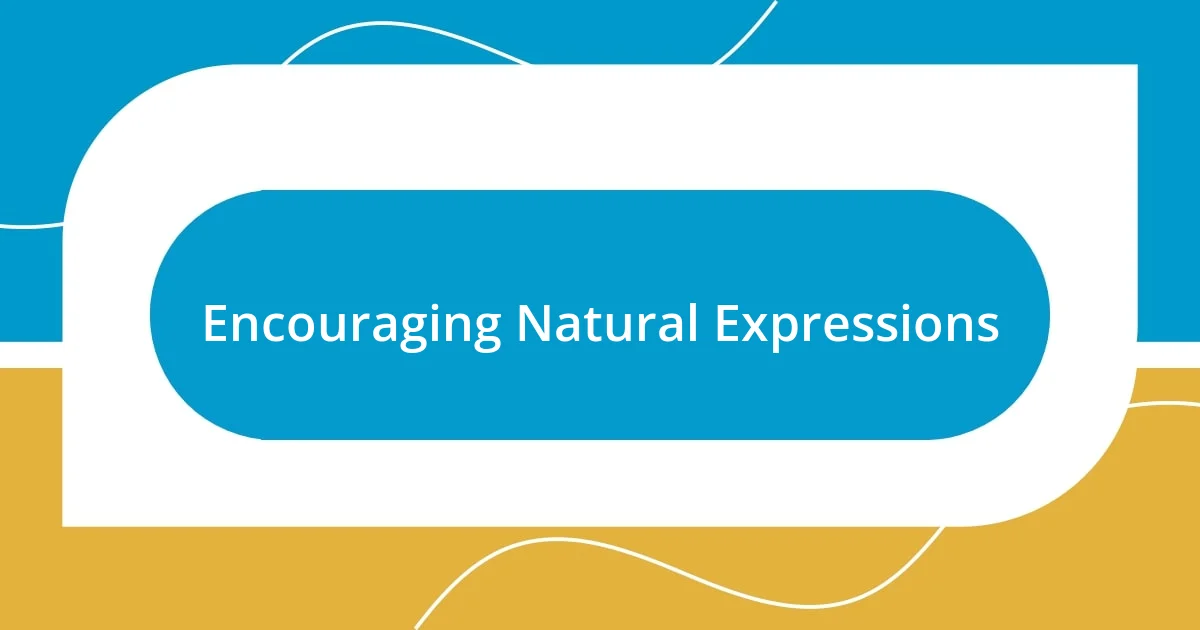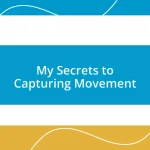Key takeaways:
- Posing significantly affects not only the photograph’s visual outcome but also the subject’s self-perception and confidence.
- Creating a comfortable environment and using clear communication can enhance the posing experience, allowing subjects to express their true selves.
- Encouraging natural expressions and practicing poses in various settings fosters authenticity and confidence during photoshoots.

Understanding the Importance of Posing
Posing might seem trivial at first glance, but it plays a crucial role in how subjects are perceived in photographs. I remember my first experience at a photoshoot; I felt stiff and awkward, which made the final images reflect that discomfort. It’s fascinating how a confident posture can transform not just the photo, but also how a person feels about themselves in that moment.
Have you ever noticed how the right pose can tell a story? I once captured a friend who was shy by nature, but when I asked her to lean slightly forward and smile genuinely, the shift was incredible. Suddenly, her personality shone through the lens, and the energy of the photo changed entirely, proving that how we position our bodies communicates so much about our self-perception and mood.
When you understand the importance of posing, you begin to realize it’s not just about creating a pretty picture; it’s about empowerment. Just think about a time when you nailed a pose and felt amazing—didn’t it boost your confidence? That connection between how we pose and how we feel can profoundly impact our interactions, both in photos and in life.

Identifying Different Posing Techniques
When diving into posing techniques, I find it essential to explore how body language can convey confidence and emotion. For instance, a relaxed posture often exudes openness, while a strong pose with shoulders back can project power. I once participated in a modeling workshop where we explored various poses, and it was eye-opening to see how a simple shift in weight could change not just the look of a pose but also the energy radiating from it.
I often categorize poses into three main techniques: static, dynamic, and expressive. Static poses, like simply standing still with a gentle smile, are great for capturing traditional portraits. In contrast, dynamic poses involve more movement and can add drama—like twisting the body slightly or using hand gestures. I recall directing a friend during a photoshoot; when she leaped into the air with her arms spread wide, we captured a moment filled with joy that echoed her vibrant personality. Expressive poses often mix elements of both static and dynamic, focusing on facial expressions and body language.
To help visualize these techniques, here’s a comparison table that summarizes the differences in posing styles:
| Pose Type | Description |
|---|---|
| Static | Stays in one place, conveying calmness or contemplation. |
| Dynamic | Incorporates movement for energy and excitement. |
| Expressive | Combines facial expressions and varied body angles to convey emotions. |

Establishing a Comfortable Environment
Creating a comfortable environment is fundamental when it comes to posing subjects confidently. I’ve noticed that when people feel at ease, their true personalities shine through. Once, during a photoshoot on a rainy day, I transformed my living room into a cozy space with soft lighting and calming music. The difference was remarkable; my subject, usually quite reserved, became so relaxed that her laughter and genuine smiles ended up imbuing the images with warmth.
Here’s a quick list of tips to establish that comfortable atmosphere:
- Choose a familiar setting: Use spaces where your subject feels at home, as this can ease tension.
- Incorporate personal items: Allow subjects to bring along meaningful objects—they often prompt natural interactions.
- Engage in light conversation: Start with casual dialogue to distract from the camera and reduce self-consciousness.
- Adjust the temperature and lighting: Ensure the environment isn’t too hot or cold; cozy lighting helps create intimacy.
- Offer positive reinforcement: Compliments can uplift spirits and help alleviate anxiety about posing.
By focusing on these elements, you create a space where subjects can truly be themselves.

Guiding Subjects with Clear Direction
When guiding subjects with clear direction, I often think of the importance of precise communication. For example, during a recent family photoshoot, I used specific phrasing like, “Turn slightly to your right and relax your shoulders.” I noticed that when I gave straightforward, actionable directions, my subjects found it easier to follow along, resulting in poses that felt more natural and confident.
In my experience, balancing directives with encouragement is key. I remember a time when I asked a couple to hold hands and look at each other while walking toward me. Initially, they looked unsure, but once I added, “Just focus on how much you love each other,” the mood shifted. Their laughter blossomed, and I captured a moment brimming with authenticity. Isn’t it fascinating how a few words can change the entire dynamic of a shoot?
Additionally, visual demonstrations play a significant role in guiding subjects. On one occasion, I mimicked a pose, showing a friend how to tilt her head slightly and place her hand on her hip. She smiled and said, “Oh, I get it now!” This immediate feedback showed me how effective it can be to guide through action, not just words. I always believe that when subjects can see what you envision, it unlocks a confident performance from them. Have you ever experienced that realization moment with your subjects? It’s truly empowering for both the photographer and the model.

Using Body Language for Confidence
Body language is a powerful tool when it comes to exuding confidence in front of the camera. I remember working with a young man who, despite being charismatic in conversation, would hunch his shoulders and avoid eye contact during his shoot. I gently reminded him, “Think of projecting energy outward; stand tall and open up your body.” Instantly, he lifted his chin and squared his shoulders. It was as if a light switch had been flipped—his newfound posture radiated confidence, and the authenticity captured in those moments was unmistakable.
It’s fascinating how small adjustments can create significant change. During a group photoshoot, I noticed a few subjects standing awkwardly with their arms crossed. I suggested they place their hands on their hips or let them dangle by their sides. The transformation was remarkable; they appeared more relaxed and approachable, almost as if they were engaging in a fun conversation rather than posing for a picture. Have you experienced how a simple posture shift can change someone’s entire presence? It’s all about inviting open, confident body language that reflects the true spirit of the individual.
Moreover, I’ve found that facial expressions are equally important in conveying confidence. A bright, genuine smile can overshadow any self-doubt and light up an image. Once, I worked with a shy teenager who struggled with expressing herself in front of the camera. I asked her to think of her favorite memory, and just like that, her face transformed. Her smile was infectious, and the joy of that moment shone through each frame. Isn’t it incredible how tapping into positive thoughts can ignite confidence and create stunning visuals? By encouraging subjects to embrace their body language and emotions, we invite them to showcase their authentic selves, which is where the magic of photography truly happens.

Encouraging Natural Expressions
Encouraging natural expressions is truly about creating a space where subjects feel comfortable being themselves. I once shot a portrait of a close friend, who, while usually expressive, struggled to connect with the moment. I decided to play a little game—asked her to think of something that made her laugh. Just that simple prompt brought about an unguarded smile, and suddenly, her laughter was infectious. It’s moments like these that remind me how a genuine connection opens the door to authenticity.
I’ve learned that tapping into emotions can yield powerful results. During a couples shoot, I noticed they were a bit stiff at first. So, I asked them to share a favorite inside joke or memory. Watching them laugh together created an electric atmosphere, and their playful banter transformed the entire session. Isn’t it amazing how shared memories can breathe life into captures? The love and joy they expressed were not only felt but beautifully preserved in the photos.
Another technique I find effective is encouraging candid moments. I remember a family shoot where I suggested that they play a little game, like ‘Simon Says,’ to break the ice. Watching them interact so naturally was heartwarming. The children forgot they were being photographed, leading to authentic expressions and playful exchanges. Have you ever noticed how genuine connections during a shoot pass unnoticed can create some of the most treasured memories? Encouraging this spontaneity makes it easier for subjects to let go of the posing stress, ultimately resulting in stunning captures that radiate emotion.

Practicing Poses for Better Results
When it comes to practicing poses, I’ve often encouraged my subjects to experiment before the actual shoot. I remember one photo session with a duo who were nervous about posing together. I suggested they rehearse a few poses in front of a mirror. Watching themselves allowed them to feel more at ease and discover their angles—by the time we started shooting, they were already bursting with confidence and comfort. Have you ever looked in the mirror and felt pleasantly surprised by your reflection? It truly makes a difference.
Another effective technique I advocate is using simple movements to create a natural flow. I once worked with a group of friends who were stiff and uncomfortable at first. I instructed them to walk toward the camera, taking turns to engage with each other. This approach not only loosened them up but also allowed their personalities to shine through. There’s something magical about moving and laughing—it’s as if the camera becomes an extension of that joyful energy. Can you remember a time when you simply let go and enjoyed the moment?
Moreover, I find that practicing poses in various environments can yield incredible results. During one memorable session in a park, I encouraged a subject to interact with her surroundings, like leaning against a tree or sitting on a bench. The spontaneity of adjusting her poses based on her comfort in each space led to strikingly authentic images. How often do we consider the impact of our environment on our demeanor? It’s a revelation that practicing poses in different settings not only builds confidence but also invites creativity into the process, resulting in photos that truly resonate with individual personalities.














